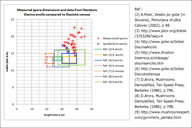|
|
click photo for larger file

Discina ancilis
Pig's Ear Fungus
|
Photographer: Dr. Amadej Trnkoczy
ID: 0000 0000 0913 0904 (2013-09-14)Copyright © 2013 Dr. Amadej Trnkoczy
|
|
INFORMATION PROVIDED WITH THE PHOTO
|
date of photo Apr 21, 2013
latitude 46.33684 longitude 13.56868
View on Google Maps.
location
Bovec basin, on top of Rabeljnik hill, East Julian Alps (Posočje, Slovenia)notes Slo.: široka medaljonka, široki hrček - Habitat: Light, mixed, predominantly hardwood woodland, nearly flat terrain, cretaceous clastic rock (flysh), partly rain protected by trees canopies, mostly in shade, precipitations ~3.000 mm/year, average temperature 8-10 deg C, elevation 490 m (1.600 feet), alpine phytogeographical region. - Substratum: heavily rotten Picea abies trunk laying on ground. - Comments: Growing solitary almost at the ground level, however attached to the wood, fruit body diameter 10.5 cm (4.1 inch), smell indistinctive, flesh rubbery but quite brittle when wet and hard and firm when dried; almost no SP, color indistinguishable; upper side of pilei brown-red (oac636), lower side appears waxy, pale whitish brown (oac718). - Measured spores pose a problem. All asci in a tissue sample I examined were sterile. This is not unusual (see Ref.:7.) since fertile asci can be found only in fully mature sporocarps. In spite of that there were several scattered spores found in the sample taken from the fertile surface with a soft wet tip of a brush (picture of the spores is a CS combo!). However, only a few were fusiform with apiculi as it should be the case with Discina ancilis. Their dimensions fit more or less to the expected dimensions. The length of the rest of the spores is OK, but they are significantly too wide and of untypical shape. Possibly they belong to another fungus (?). Oil drops are also missing. Possibly these drops develop only in fully mature spores? Asci and paraphyses dimensions fit to expectations. Very similar Disciotis venosa has much smaller spores and distinct smell on chlorine. It also grows on soil, which was not the case with this observation. - Spores smooth. Dimensions (all spores found): 37.6 (SD = 3.2) x 18.6 (SD = 2.4) μ, Q = 2,04 (SD = 0.26), n = 30; if only spindle form spores with apiculi are taken into account and measured without apiculi: 34,3 (SD = 2,9) x 15,8 (SD = 1,2) μ, Q = 2,2 (SD = 0.4), n = 5. Paraphyses septated, with swollen tips, full of grains, diameter about 7-9 μ at the tip and 4.5-6 μ in the middle, densely clustered. Asci sterile (no spores visible), about 16-20 μ diameter and about 450 μ in length. Olympus CH20, NEA 40x/1.25, magnification 400x in water, Congo red. AmScope MA500 digital camera. - Herbarium: Mycotheca and lichen herbarium (LJU-Li) of Slovenian Forestry Institute, Večna pot 2, Ljubljana, Index Herbariorum LJF. - Ref.: (1) Personal communication with Mr. Bojan Rot. (2) A.Poler, Veselo po gobe (in Slovene), Mohorjeva družba Celovec (2002), p 48. (3) http://www.jstor.org/stable/3753296?seq=4 (4) http://www.gobe.si/Gobe/DiscinaAncilis (5) http://www.drustvo-bisernica.si/oldpage/discinaancilis.htm (6) http://www.gobe.si/Gobe/DisciotisVenosa (7) D.Arora, Mushrooms Demystified, Ten Speed Press, Berkeley (1986), p 796. (8) D.Arora, Mushrooms Demystified, Ten Speed Press, Berkeley (1986), p 798. (9) http://www.mushroomexpert.com/gyromitra_perlata.html (10 ) R.M. Davis, R. Sommer, J.A. Menge, Mushrooms of Western North America, UC Press, Berkeley (2012), p 404. (11) D.Arora, Mushrooms Demystified, Ten Speed Press, Berkeley (1986), p 798. (12) http://www.rogersmushrooms.com/gallery/DisplayBlock~bid~5692.aspcontributor's ID # Bot_705/2013_DSC6028 photo category: Fungi - fungi
|
MORE INFORMATION ABOUT THIS FUNGUS
|
| common names
Pig's Ear Fungus (photographer)
View all photos in CalPhotos of Discina ancilis Check Google Images for Discina ancilis |
|
The photographer's identification Discina ancilis has not been reviewed. Click here to review or comment on the identification. |
|
Using this photo The thumbnail photo (128x192 pixels) on this page may be freely used for personal or academic purposes without prior permission under the Fair Use provisions of US copyright law as long as the photo is clearly credited with © 2013 Dr. Amadej Trnkoczy.
For other uses, or if you have questions, contact Dr. Amadej Trnkoczy amadej.trnkoczy[AT]siol.net. (Replace the [AT] with the @ symbol before sending an email.) |
|
|
